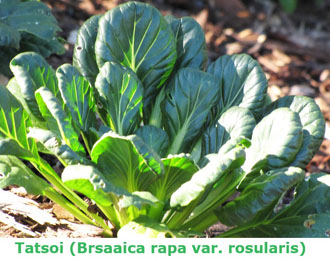Tatsoi Nutrition facts
Tatsoi is a small, low-spreading plant that grows a dense rosette of oval, spoon-shaped leaves. The leaves are glossy with a slight, cupped appearance with a mild, subtly tangy flavor and packed with essential phytonutrients that contribute to overall well-being and health.
This cool season plant is classified in the family of Brassicaceae, and known scientifically as Brassica rapa subsp. narinosa or Brassica rapa var. rosularis. The other common names of this Asian green are tat choy, Chinese flat cabbage, and spoon mustard.
 |
Tatsoi can be found during spring and fall seasons, and in more temperate regions, it can be cultivated throughout the year. It can withstand frost, snow, and cold temperatures.
Tatsoi is a short-term crop that reaches harvestable size within a span of 45 to 50 days. It typically grows a range of 20 to 25 centimeters in height and 25 to 30 centimeters in diameter. These leaves are initially harvested at around 10 centimeters in length and come in shades ranging from light to dark green. They boast a smooth, velvety surface with gentle ripples and well-defined veins that converge into either a white or green stem, depending on the variety.
Tatsoi Health benefits
Tatsoi (spoon mustard) leaves and stems are the storehouses of numerous phytonutrients that have health promotional and disease prevention properties.
It is very low in calories (13 calories per 100 g raw leaves) and fats. However, its dark green leaves are rich in antioxidants, vitamins, and minerals.
Tatsoi greens provide a notable amount of dietary fiber. Research indicates that adequate intake of soluble and insoluble fibers in one's diet aids in managing cholesterol levels by impeding its absorption in the gut. A diet rich in fiber also supports regular bowel movements, alleviating constipation and potentially providing protection against conditions like hemorrhoids and colon cancer.
Tatsoi contains an abundance of antioxidants such as flavonoids, glucosinolates, indoles, sulforaphane, carotenes, lutein, and zeaxanthin. Particularly, indoles like Di-indolyl-methane (DIM) and sulforaphane have demonstrated notable advantages in inhibiting cancer-cell growth and exhibiting cytotoxic effects on prostate, breast, colon, and ovarian cancers.
Fresh spoon mustard leaves also provide a moderate amount of other B-complex vitamins like thiamin, riboflavin, niacin, pantothenic acid, and more. Several of these vitamins serve as crucial cofactors in substrate metabolism within the human body.
Fresh spoon mustard leaves are excellent sources of vitamin C. 3.5 Oz (100 g) fresh leaves provide 31 mg or about 34% of RDA. Vitamin C (ascorbic acid) is a powerful natural antioxidant supporting the immune system, protecting the cells against free radical damage, and aiding in the reduction of inflammation.
Tatsoi leaves serve as moderate sources of vitamin A, offering 540 IU or 18% of the Recommended Dietary Allowance (RDA) per 3.5 ounces (100 grams). Vitamin A is a crucial nutrient necessary for maintaining healthy mucosa, hair, and skin. Including natural foods abundant in flavonoids in your diet can contribute to protection against lung and oral cavity cancers.
It is an incredible source of vitamin K, providing 220 mg (183% RDA) per 100 grams. Vitamin K has shown potential in enhancing bone mass through the promotion of osteoblastic activity in bones. Additionally, it plays an established role in Alzheimer's disease by limiting neuronal damage in the brain.
Fresh tatsoi is an excellent source of several essential minerals such as calcium 150 mg (15% RDA), iron (9% RDA), magnesium, potassium 430 mg/100 g), zinc, selenium, and manganese (18% RDA).
It is evident from the research studies that regular consumption of tatsoi as part of the diet is known to prevent arthritis, osteoporosis, iron deficiency anemia, and is believed to offer protection from cardiovascular diseases, asthma, and colon and prostate cancers.
| Principle | Nutrient Value | Percent of RDA |
|---|---|---|
| Energy | 13 Kcal | 1% |
| Carbohydrates | 2.2 g | 1.7% |
| Protein | 1.3 g | 2% |
| Total Fat | 0.2 g | 1% |
| Cholesterol | 0 mg | 0% |
| Dietary Fiber | 1.9 g | 5% |
| Vitamins | ||
| Folates | 65 μg | 16% |
| Niacin | 0.9 mg | 5.6% |
| Pantothenic acid | 0.19 mg | 4% |
| Vitamin B6 | 0.12 mg | 9% |
| Riboflavin | 0.09 mg | 7% |
| Thiamin | 0.05 mg | 4% |
| Vitamin A | 540 IU (180 RAE) | 18% |
| Vitamin C | 31 mg | 34% |
| Vitamin K | 220 mg | 183% |
| Electrolytes | ||
| Sodium | 29 mg | 2% |
| Potassium | 430 mg | 9% |
| Minerals | ||
| Calcium | 120 mg | 12% |
| Copper | 0.05 mg | 5.5% |
| Iron | 0.7 mg | 9% |
| Magnesium | 23 mg | 6% |
| Manganese | 0.38 mg | 16% |
| Zinc | 0.5 mg | 4.5% |
Selection and storage
Tatsoi, originating from Asia, was traditionally linked with Asian cuisine, but now, these greens have transcended borders and integrated into diverse culinary styles globally. They are commercially cultivated and grown in home gardens. When in season, they are readily available fresh at farmer's markets, specialty grocers, and in home gardens.
Tatsoi can be harvested at early stages for baby leaves and later for dark-green leaves and nutritious petioles. While young, its leaves have a mild flavor and are prepared much like spinach.
At home, tatsoi will be kept for 3 to 5 days when unwashed, wrapped in a damp paper towel, and stored in a plastic bag in the refrigerator. store it in the refrigerator soon after buying as they wither soon if kept at room temperature.
Use fresh tatsoi greens as soon as possible to enjoy special flavor and health benefits.
Preparation and serving methods
Tatsoi (tat choy) is a popular green-leafy vegetable in Cantonese, Korean, and Japanese cuisine. Fresh leaves, flower buds, and stalks are used in a variety of cuisines all over East Asia.
To prepare, wash the leaves thoroughly in clean running water to remove sand/dirt, and then rinse in saline water for about 15-30 minutes to remove any insecticide residues. Trim off any thick petioles and stems.
Here are some serving tips:
Tatsoi is a versatile leafy green with a gentle, subtly tangy, semi-bitter taste well suited for raw or lightly cooked dishes. Young leaves are often favored for mixed salads and are an excellent addition to other greens such as spinach, arugula, watercress, pea tendrils, and mizuna.
The leaves and stems offer versatility in cooking—they can be finely chopped and incorporated into quiche, stir-fried alongside other vegetables, sautéed to accompany fish, wilted with warm sauces for a smoother texture, or added to soups right before serving for added flavor and texture.
 |
| Pizza with crimini mushrooms, tatsoi, mozzarella. Courtesy: Timothy Vollmer |
Young, tender, baby leaves of tat choy are enjoyed raw in salads, or layered into sandwiches.
The crisp greens can be used as a substitute in recipes for bok choy, and spinach. Tatsoi is also frequently utilized in briefly cooked preparations, including stir-frying, sautéing, steaming, and braising.
Tatsoi can be pickled (kimchi) to extend its shelf life.
In Japan, tatsoi greens are commonly paired with umami-rich ingredients like scallops, mushrooms, and seaweed to enhance flavors.
Tatsoi offers further culinary options: it can be added as a flavorful topping for pizza and tacos, or blended into pesto for a distinctive twist.
Safety profile
The presence of phytates and dietary fiber in tatsoi might impede the absorption of iron, calcium, and magnesium.
Tatsoi, as a member of the Brassica family, contains oxalic acid, a naturally occurring substance found in certain vegetables that could crystallize as oxalate stones in the urinary tract for some individuals. Those with a history of oxalate urinary tract stones are recommended to avoid consuming vegetables from the Brassica family. It's essential to maintain adequate water intake to support normal urine output.
Tat choy might also contain goitrogens, which have the potential to disrupt thyroid hormone production and lead to a deficiency in thyroxine hormone for individuals with thyroid issues.
(Medical Disclaimer: The information and reference guides on this website are intended solely for the general information of the reader. It is not to be used to diagnose health problems or for treatment purposes. It is not a substitute for medical care provided by a licensed and qualified health professional. Please consult your health care provider for any advice on medications.)
You may also like to read ≻≻
≺≺ Mizuna Nutrition facts.
≺≺ Broccoli rabe Health benefits.
≺≺ Chinese broccoli (Gai lan) Health benefits.
≺≺ Komatsuna Health benefits.
≺≺ Mustard-greens Health benefits.
≺≺ Back to Vegetables from tatsoi. Visit here for an impressive list of vegetables with complete illustrations of their nutrition facts and health benefits.
≺≺ Back to Home page.
Further reading:
Tatsoi- Specialty Produce (Link opens in new window).
Refer Stanford School of Medicine Cancer information Page- Nutrition to Reduce Cancer Risk (Link opens in new window).
Kitazawa Seed Company (Link opens in new window).
Tatsoi- Get to know (Link opens in new window).